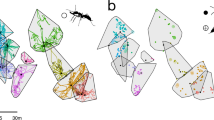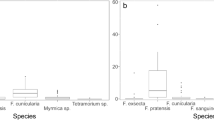Abstract
The Malagasy endemic ant Malagidris sofina (Bolton and Fisher 2014) nests on cliff faces in natural rock alcoves or clay banks. Colonies have single ergatoid queens and reproduce by fission. Each nest has a funnel-shaped entrance that projects horizontally from the cliff face. We examine three hypotheses for the function of the funnels—water exclusion, gas exchange and defense. Entrance funnels are relatively impermeable and divert water from nests, but simple tubes would achieve the same result. Consistent with the gas exchange hypothesis, projected funnel entrances likely increase gas exchange rates over sixfold compared to simple tubes and may increase air flow within the nest. Gas exchange may explain the recurrent evolution of funnel entrances in several ant lineages, especially among cliff dwelling species. We outline M. sofina defense responses to conspecifics and co-occurring ant species, and find no support for a defense role of entrance funnels. Workers display little aggression but respond to several species with an original form of nest defense––cliff jumping—in which workers drop off the cliff face while clinging to invaders and then return to their nest. M. sofina is a restricted range species under threat of extinction by habitat destruction. Its novel lifestyle underscores the urgency of exploration and conservation in a tropical biodiversity hotspot.




Similar content being viewed by others
References
AntWeb 2014. http://www.antweb.org. Accessed 23 January 2014
Bolton B. and Fisher B.L. 2014. The Madagascan endemic myrmicine ants related to Eutetramorium (Hymenoptera: Formicidae): taxonomy of the genera Eutetramorium Emery, Malagidris nom. n., Myrmisaraka gen. n., Rovidris gen. n., and Vitsika gen. n. Zootaxa 3791: 1-99
Callmander M.W., Buerki S. and Wolhauser S. 2008. A new threatened species of Pandanaceae from Northwestern Madagascar, Pandanus sermolliana. Novon 18: 421-424
Callmander M.W., Rakotovao C., Razafitsalama J., Phillipson P.B., Buerki S., Hong-Wa C., Rakotoarivelo N., Andriambololonera S., Koopman M.M., Johnson D.M., Deroin T., Ravoahangy A., Solo S., Labat J. and Lowry P.P. II 2009. New species from the Galoka and Kalabenono massifs: two unknown and severely threatened mountainous areas in NW Madagascar. Candollea 64: 179-202
Cronin A., Molet M., Doums C., Monnin T. and Peeters C. 2013. Recurrent evolution of dependent colony foundation across eusocial insects. Annu. Rev. Entomol. 58: 37-55
Cox M.D. and Blanchard G.B. 2000. Gaseous templates in ant nests. J. Theor. Biol. 204: 223-238
Crosland M.W.J. 1995. Nest and colony structure in the primitive ant, Harpegnathos venator (Smith) (Hymenoptera: Formicidae). Pan-Pac. Entomol. 71: 18-23
Federle W., Rohrseitz K. and Hölldobler B. 2000. Attachment forces of ants measured with a centrifuge: better ‘wax-runners’ have a poorer attachment to a smooth surface. J. Exp. Biol. 203: 505-512
Federle W., Baumgartner W. and Hölldobler B. 2004. Biomechanics of ant adhesive pads: frictional forces are rate- and temperature-dependent. J. Exp. Biol. 206: 67-74
Fisher B.L. 2003. Ants (Formicidae: Hymenoptera). In: The Natural History of Madagascar (Goodman S.M. and Benstead J.P., Eds), University of Chicago Press, Chicago. pp 811-819
Ganzhorn J.U., Lowry P.P., Schatz G.E. and Sommer S. 2001. The biodiversity of Madagascar: one of the world’s hottest hotspots on its way out. Oryx 35: 346-348
Goodman S.M. and Benstead J.P. 2005. Updated estimates of biotic diversity and endemism for Madagascar. Oryx 39: 73-77
Hölldobler B. and Wilson E.O. 1990. The Ants. Belknap Press of Harvard University Press, Cambridge, MA
Holm S. 1979. A simple sequentially rejective multiple test procedure. Scand. J. Stat. 6: 65-70
Howse P.E. 1966. Air movement and termite behaviour. Nature 210: 967-968
Kleineidam C., Ernst R. and Roces F. 2001. Wind-induced ventilation of the giant nests of the leaf-cutting ant Atta vollenweideri. Naturwissenschaften 88: 301-305
Kleineidam C. and Roces F. 2000. Carbon dioxide concentrations and nest ventilation in nests of the leaf-cutting ant Atta vollenweideri. Insect. Soc. 47: 241-248
Kleineidam C. and Tautz J. 1996. Perception of carbon dioxide and other “air-condition” parameters in the leaf cutting ant Atta cephalotes. Naturwissenschaften 83: 566-568
Legendre P. 2011. Lmodel2: Model II Regression. R package version 1.7-0. http://CRAN.R-project.org/package=lmodel2. Accessed 27 January 2014
Lighton J.R.B. and Fielden L.J. 1995. Mass scaling of standard metabolism in ticks: a valid case of low metabolic rates in sit and wait strategists. Physiol. Zool. 68: 43-62
Longino J.T. 2005. Complex nesting behavior by two Neotropical species of the ant genus Stenamma (Hymenoptera: Formicidae). Biotropica 37: 670-675
Lüscher M. 1961. Air conditioned termite nests. Sci. Am. 205: 138-145
Martin P.J. 1991. Respiration of the ant Leptothorax unifasciatus (Hymenoptera, Formicidae) at individual and society levels. J. Insect Physiol. 37: 311-318
McArdle B.H. 1988. The structural relationship: regression in biology. Can. J. Zool. 66: 2329-2339
Mueller U.G. and Wcislo W.T. 1998. Nesting biology of the fungus-growing ant Cyphomyrmex longiscapus Weber (Attini, Formicidae). Insect. Soc. 45: 181-189
Myers N., Mittermeier R.A., Mittermeier C.G., da Fonseca G.A.B. and Kent J. 2000. Biodiversity hotspots for conservation priorities. Nature 403: 853-858
Peeters C. 2012. Convergent evolution of wingless reproductives across all subfamilies of ants, and sporadic loss of winged queens (Hymenoptera: Formicidae). Myrmecol. News 16: 75-91
Peeters C., Hölldobler B., Moffett M. and Musthak Ali T.M. 1994. “Wall-papering” and elaborate nest architecture in the ponerine ant Harpegnathos saltator. Insect. Soc. 41: 211-218
Pérez-Ortega B., Fernández-Marín H., Loiácono M.S., Galgani P. and Wcislo W.T. 2010. Biological notes on a fungus-growing ant, Trachymyrmex cf. zeteki (Hymenoptera, Formicidae, Attini) attacked by a diverse community of parasitoid wasps (Hymenoptera, Diapriidae). Insect. Soc. 57: 317-322
Porter S.D. and Tschinkel W.R. 1985. Fire ant polymorphism: the ergonomics of brood production. Behav. Ecol. Sociobiol. 16: 323-336
R Core Team 2013. R: A language and environment for statistical computing. R Foundation for Statistical Computing, Vienna, Austria. ISBN 3-900051-07-0, URL http://www.R-project.org/. Accessed 27 January 2014
Roubik D.W. 2006. Stingless bee nesting biology. Apidologie 37: 124-143
Sendova-Franks A.B. and Franks N.R. 1995. Spatial relationships within nests of the ant Leptothorax unifasciatus (Latr.) and their implications for the division of labour. Anim. Behav. 50: 121-136
Shik J.Z., Donoso D.A. and Kaspari M. 2013. The life history continuum hypothesis links traits of male ants with life outside the nest. Entomol. Exp. Appl. 149: 99-109
Tschinkel W.R. 1993. Resource allocation, brood production and cannibalism during colony founding in the fire ant, Solenopsis invicta. Behav. Ecol. Sociobiol. 33: 209-223
Tschinkel W.R. 2004. The nest architecture of the Florida harvester ant, Pogonomyrmex badius. J. Insect Sci. 4: 21
Vogel S. 1994. Life in Moving Fluids: The Physical Biology of Flow, 2nd edn. Princeton University Press, Princeton
Vogel S., Ellington C.P. Jr and Kilgore D.L. Jr 1973. Wind-induced ventilation of the burrow of the prairie-dog, Cynomys ludovicianus. J. Comp. Physiol. 85: 1-14
Vogt J.T. and Appel A.G. 1999. Standard metabolic rate of the fire ant, Solenopsis invicta Buren: effects of temperature, mass, and caste. J. Insect Physiol. 45: 655-666
Weir J.S. 1973. Air flow, evaporation and mineral accumulation in mounds of Macrotermes subhyalinus (Rambur). J. Anim. Ecol. 42: 509-520
Yanoviak S.P., Munk Y. and Dudley R. 2011. Evolution and ecology of directed aerial descent in arboreal ants. Integr. Comp. Biol. 51: 944-956
Acknowledgments
We thank the Republic of Madagascar and local communities for allowing us to work on Galoko. The fieldwork on which this study is based could not have been completed without the gracious support of the Malagasy people and the Arthropod Inventory Team (Balsama Rajemison, Jean Claude Rakotonirina, Jean-Jacques Rafanomezantsoa, Chrislain Ranaivo, Hanitriniana Rasoazanamavo, Nicole Rasoamanana, Clavier Randrianandrasana). Rosemary Knapp at the University of Oklahoma granted us the use of her lab. Flavia Esteves provided a helpful reference. The expedition was funded in part by National Science Foundation Grant No DEB-0842395. JAH is funded by a National Science Foundation Graduate Research Fellowship and a University of Oklahoma Alumni Fellowship.
Author information
Authors and Affiliations
Corresponding author
Electronic supplementary material
Below is the link to the electronic supplementary material.
Supplemental Video A Malagidris sofina worker demonstrates cliff jumping by carrying an invading Cerapachys sp. out of the nest and dropping off the cliff with it.
Supplementary material 1 (MP4 44462 kb)
Rights and permissions
About this article
Cite this article
Helms, J.A., Peeters, C. & Fisher, B.L. Funnels, gas exchange and cliff jumping: natural history of the cliff dwelling ant Malagidris sofina . Insect. Soc. 61, 357–365 (2014). https://doi.org/10.1007/s00040-014-0360-8
Received:
Revised:
Accepted:
Published:
Issue Date:
DOI: https://doi.org/10.1007/s00040-014-0360-8




